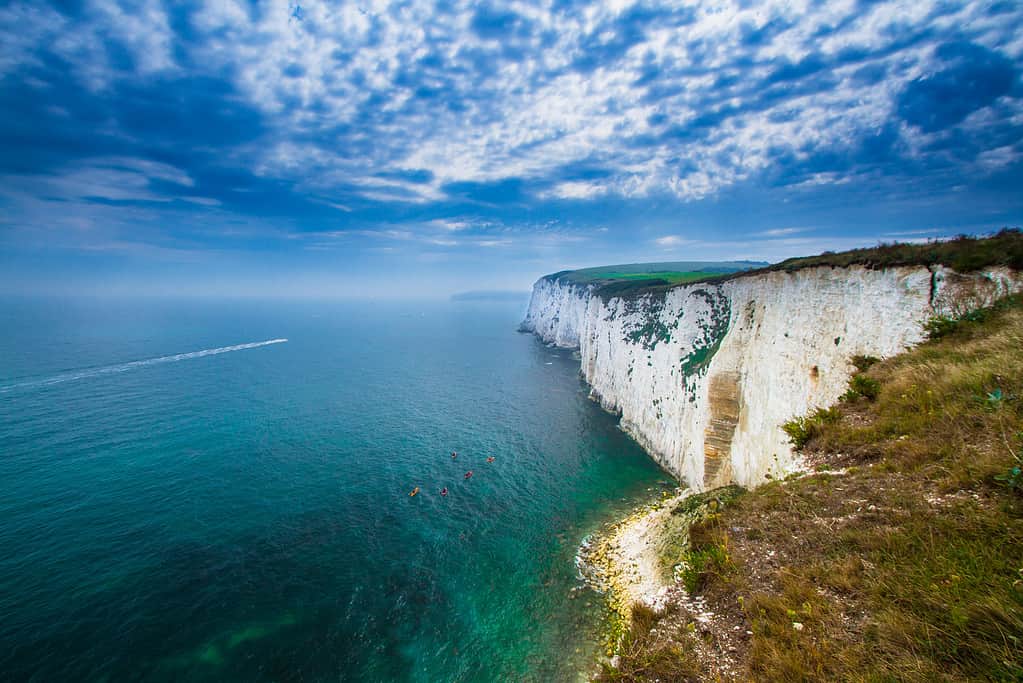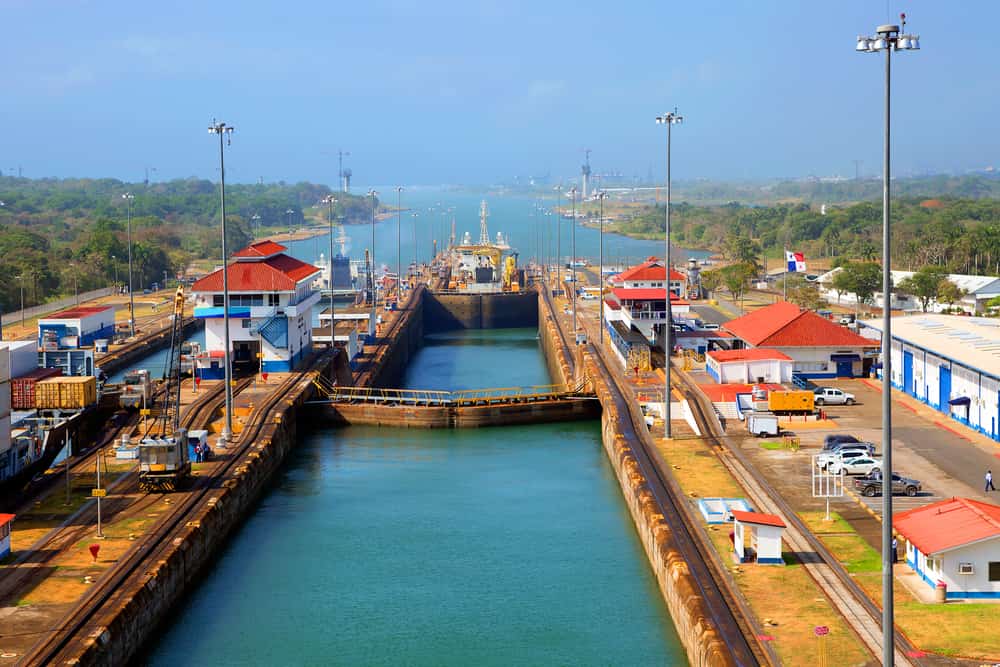A channel is a waterway between two land masses that are very close to each other. They can be found all over the world and many of them are man-made. The English Channel between England and France is one famous example. The English Channel has provided the United Kingdom with a great military defense. They can foresee when enemies could be on their way to the mainland, like in 1940 during World War II.
But how wide is the English Channel? As with all bodies of water and land masses, the size of the channel varies. Let’s explore the length, depth, and width of the English Channel. We’ll also take you on an adventure on the wildlife living in and around the channel, as well as some fun facts.
How Wide is the English Channel?

The English Channel is known as “Muir nIocht,” which means merciful sea in Irish Gaelic.
©AmArtPhotography/iStock via Getty Images
The English Channel is 150 miles wide at the widest part of it and the narrowest is only 21 miles wide. At its narrowest point, if you stand in Calais, you can see the Dover cliffs on a clear day. The narrowest part of the channel has also provided regular transportation between the two nations. Ferries still cross regularly between both countries, however not as frequently now because of the Channel Tunnel.
In terms of length, the English Channel is 350 miles long. It is also a shallow body of water being only 207 feet deep at its average, and 571 feet deep at its deepest. The deepest part of the English Channel is located at Hurd’s Deep near the isle of Guernsey.
Wildlife in the Channel and Surrounding Areas

Bulgarian swimmer Peter Stoychev was able to swim the channel in record time, about 7 hours.
©Irving Bartlett/iStock via Getty Images
The English Channel is home to a diverse group of animals and marine life. If you’re lucky, you can spot many animals swimming in the channel. On land, many species of animals have made their home in the area. The diverse wildlife in the English Channel area has prompted environmental groups to combat human pollution from plaguing the area.
Flora
The flora surrounding the English Channel is vast and extensive. Southern England is home to lush forests and tall white cliffs. Beautiful wildflowers grow rampant on the White Cliffs of Dover, and there is a huge variety of trees all along Southern England. Northern France also has a wide variety of plants like heather, fern, and more.
The English Channel is also home to 44% of bacteria that can be found all over the world’s oceans. Scientists made this discovery as they wanted to collect water samples to see if rare species that had not been discovered lived in the channel.
Fauna
The fauna in and around the English Channel is extensive. You can spot seals, whales, dolphins, and sharks swimming in the channel. The birds that you can see flying above the channel and nearby land are puffins, and razorbills, among others. The channel provides a great feeding ground for birds, as there are a lot of species of fish for their consumption. Among the fish in the channel are cod, sole, and hammock. This has ensured fishing around the channel is a successful industry.
There is also a species of fish called the monkfish that fishermen nicknamed “the poor man’s lobster. The monkfish calls the English Channel home and it’s one of the only places in the world where they live. They aren’t the prettiest of fish, but very popular for consumption.
History of the English Channel

Matthew Webb was the first person who swam the English Channel in 1875 in about 22 hours.
©Matthew Troke/iStock via Getty Images
The English Channel naturally separates the UK and France, providing an accessible waterway from the Atlantic Ocean to the North Sea through the Dover Strait, which happens to be the busiest waterway in the world.
Called La Manche in France, the English Channel has witnessed many maritime invasions — like the Spanish Armada, the Napoleonic Wars, and Nazi Germany’s attempt to invade England. Because of this, the Channel has served as an important naval access point for the British. They have successfully pushed off enemies by quickly detecting their arrival.
The Channel has also been subject to illegal immigration. They have used the channel tunnel as a quick means to get to the UK from the continent. Immigrants have also crossed by sea vessel, prompting the UK government to crack down.
The Channel Tunnel
The Channel Tunnel is the longest underwater tunnel in the world and the third-longest railway tunnel in the world. Construction on the channel started in 1988 and was completed in 1994, costing more than 26 billion dollars. The tunnel now links the UK with the continent of Europe without using sea vessels. Nearly 6 million passengers cross the Strait of Dover through the Channel Tunnel every year.
The Channel Tunnel has impacted the economy in a hugely positive way because it has seen an increase in traffic with the shipment of goods, as well as an increase in traffic between the UK and France.
Other Channels
There are other channels, or canals, in the world that are significant in their way. Two of them provide links between two bodies of water and the third is equally as important for China’s economy.
Strait of Gibraltar

The Strait of Gibraltar, connecting the Atlantic Ocean and the Mediterranean Sea, is one of the busiest waterways in the world.
©marcelina1982/iStock via Getty Images
The Strait of Gibraltar is a major waterway that connects the Atlantic Ocean and the Mediterranean Sea. It is also between Spain and Morocco, separating the continents of Europe and Asia. At its narrowest, only 8.1 miles separates Punta de Tarifa in southern Spain and Point Cires in northern Morocco. Like the English Channel, there is an abundance of illegal immigration from northern Africa to Europe on the strait. This is due to its location and proximity to the European continent. Currently, there are possible plans to create a tunnel similar to the Channel Tunnel.
Panama Canal

Over 25,000 people died during the Panama Canal’s construction.
©Galina Savina/Shutterstock.com
The Panama Canal came to be in the early 1880s because for ships to travel from the Atlantic Ocean to the Pacific, they would have to traverse the entire South American continent. To cut time, it was decided to create a canal in Panama. France started construction but because of lack of funding and thousands of deaths, they stopped and the US took over construction. It took more than 30 years to complete until the canal opened in 1914. It is one of the busiest waterways in the world with 14,000 ships traveling through the canal every year.
Grand Canal

The Grand Canal is one of the oldest canals in the world, with the oldest part of it built around the 5th century BC.
©Wei Wu/iStock via Getty Images
The Grand Canal in China is the longest in the world, with a total length of 1,104 miles. It provides shipping and trading access through a man-made waterway from Beijing to both the southeastern and northeastern regions of the country. It also links the Yellow and Yangtze Rivers. The canal started construction as early as the 5th century BC and over the years, it was expanded. The canal has been a force in unifying north and south China, as well as fortifying the economies of both regions.
Conclusion
And there you have it, the English Channel has been of formidable use to the British. It has created a natural defense against enemies, it has been a link between Great Britain and the rest of Europe.
If you find yourself visiting England or France, a trip to Dover or Calais may be worth your while, as you may be able to see the other side on a clear day. It’ll provide you with some nice pictures and your surroundings will provide you with a breath of fresh air.
The photo featured at the top of this post is © Tudoran Andrei/Shutterstock.com
Thank you for reading! Have some feedback for us? Contact the AZ Animals editorial team.







